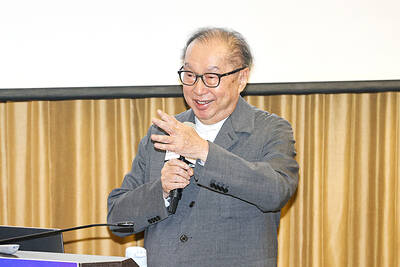Notebook computer maker Wistron Corp (緯創) reported a 90 percent year-on-year growth in profit in the first quarter, thanks to strong growth in laptop shipments and its diversification into non-notebook products.
Profits last quarter reached NT$2.7 billion (US$81.8 million), or earnings per share of NT$1.45, the company said in a statement yesterday.
Sales jumped 27.4 percent from a year earlier to NT$143.4 billion, while gross margin rose to 5.27 percent from 4.95 percent.
“We believe there will be no surprises in the second quarter,” chief financial officer Henry Lin (林進財) told an investor conference call, adding that business performance for the year should also be in line with the company’s expectations.
Notebook shipments in the current quarter are expected to rise by 5 to 10 percent sequentially, while non-notebook products — such as LED TV, all-in-one PCs, monitors and handheld devices — would see “higher percentage growth,” he said
Like other contract notebook makers such as Quanta Computer Inc (廣達電腦) and Compal Electronics Inc (仁寶電腦), Wistron is also facing the pressure of margin erosion after Hon Hai Precision Industry Co (鴻海精密), the world’s largest electronic component maker, ventured into notebook production last year.
“After losing Hewlett-Packard Co’s consumer notebook orders and with Hon Hai joining the industry, Wistron has adopted a new strategy — diversifying into non-notebook product lines that offer better profit margins,” Grand Cathay Securities (大華證券) said in a report dated April 9.
Notebooks’ contribution to Wistron’s total revenues is projected to drop to below 70 percent this year, down from last year’s 70 percent to 75 percent, Grand Cathay said.
Company CEO Simon Lin (林憲銘) yesterday said diversification should help Wistron maintain its margins, with shipments of desktops, monitors and TVs expected to grow this year and increase even more next year.
“These [non-notebook products] will cushion the impact [from competition in the notebook market] and help us protect margins,” he said. Notebooks’ contribution to overall sales will decline to about 50 percent next year, he added.
The company expects to see major order deliveries of its all-in-one desktops and TVs in the coming quarters.
Citing TVs as an example, Simon Lin said Wistron’s production volume is expected to double to 12 million units next year, which would help the company in cutting down costs as economies of scale grow.
Wistron’s board yesterday approved a proposal to distribute cash dividends of NT$2.70 and a stock dividend of 5 percent.
To cope with future expansion, the board approved a fund-raising proposal to issue no more than 250 million common shares or global depositary receipts.
The company plans to invest US$20 million to form an e-waste recycling company in Kunshan, China, as part of its green business development.
It will plans to invest US$10 million into iSGT Global (新設信息超級網格集團) and its Chinese subsidiary to develop cloud computing businesses.

BYPASSING CHINA TARIFFS: In the first five months of this year, Foxconn sent US$4.4bn of iPhones to the US from India, compared with US$3.7bn in the whole of last year Nearly all the iPhones exported by Foxconn Technology Group (富士康科技集團) from India went to the US between March and last month, customs data showed, far above last year’s average of 50 percent and a clear sign of Apple Inc’s efforts to bypass high US tariffs imposed on China. The numbers, being reported by Reuters for the first time, show that Apple has realigned its India exports to almost exclusively serve the US market, when previously the devices were more widely distributed to nations including the Netherlands and the Czech Republic. During March to last month, Foxconn, known as Hon Hai Precision Industry

Taiwan Semiconductor Manufacturing Co (TSMC, 台積電) and the University of Tokyo (UTokyo) yesterday announced the launch of the TSMC-UTokyo Lab to promote advanced semiconductor research, education and talent development. The lab is TSMC’s first laboratory collaboration with a university outside Taiwan, the company said in a statement. The lab would leverage “the extensive knowledge, experience, and creativity” of both institutions, the company said. It is located in the Asano Section of UTokyo’s Hongo, Tokyo, campus and would be managed by UTokyo faculty, guided by directors from UTokyo and TSMC, the company said. TSMC began working with UTokyo in 2019, resulting in 21 research projects,

Ashton Hall’s morning routine involves dunking his head in iced Saratoga Spring Water. For the company that sells the bottled water — Hall’s brand of choice for drinking, brushing his teeth and submerging himself — that is fantastic news. “We’re so thankful to this incredible fitness influencer called Ashton Hall,” Saratoga owner Primo Brands Corp’s CEO Robbert Rietbroek said on an earnings call after Hall’s morning routine video went viral. “He really helped put our brand on the map.” Primo Brands, which was not affiliated with Hall when he made his video, is among the increasing number of companies benefiting from influencer

Quanta Computer Inc (廣達) chairman Barry Lam (林百里) yesterday expressed a downbeat view about the prospects of humanoid robots, given high manufacturing costs and a lack of target customers. Despite rising demand and high expectations for humanoid robots, high research-and-development costs and uncertain profitability remain major concerns, Lam told reporters following the company’s annual shareholders’ meeting in Taoyuan. “Since it seems a bit unworthy to use such high-cost robots to do household chores, I believe robots designed for specific purposes would be more valuable and present a better business opportunity,” Lam said Instead of investing in humanoid robots, Quanta has opted to invest